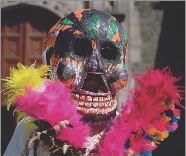1 TRY OUT LANGUAGE
2 LEARN GRAMMAR
3 APPLY ON YOUR OWN
Use Compound Sentences
An independent clause expresses a complete thought. It can stand alone as a sentence. When you join two independent clauses, you make a compound sentence.
The words and, but, and or are conjunctions. They join the two clauses. A comma (,) comes before the conjunction.
| EXAMPLE | Leon puts on the green mask, and I put on the blue one. |
• Use and to join similar or related ideas.
EXAMPLE Jorge cuts out the mask, and Maya paints it. • Use but to join different or opposite ideas.
EXAMPLE Tessa thinks the mask is scary, but I think it looks funny. • Use or to show a choice.
EXAMPLE You can wear the mask, or you can hang it on a wall.
Practice Together
Say each pair of sentences. Combine them with and, but, or or to make a compound sentence. Say the sentence.
1. People wear masks during celebrations. They have parades.
2. Some masks are old. Other masks are new.
3. Do you like traditional masks? Do you prefer new ones?
4. A mask might be made of paper. A mask might be made of wood.
5. Some masks are supposed to scare people. People still enjoy them.

This is a Day of the Dead mask, and it is from Mexico City.
Try It!
Read each pair of sentences. Combine the pair using and, but, or or to make a compound sentence. Write the conjunction on a card. Then hold up the card as you say the sentence.
6. I might wear a clown mask for the parade. I might wear a tiger mask.
7. My father bought a dancer’s mask in Guatemala. He bought a theater mask in Japan.
8. You can buy a carnival mask in Puerto Rico. You can find one on the Internet.
9. We have three African masks on our living room wall. They are all handmade.
10. I like all the masks. My favorite is the long, thin one with the surprised expression.